The Roman 'gate to hell' in Turkey's ancient city of Hierapolis was long thought to be an entrance to the underworld.
Romans used the gate to stage sacrificial rituals in which castrated priests would walk through the entrance with healthy bulls.
The bulls would die during the ritual, but the priests would return unscathedand now scientists think they know why.
Experts believe that a quirk of geology and the temple's layout may explain the mysterious phenomenon.
Deadly levels of carbon dioxide were uncovered at ground level which sacrificial animals could not escape, but did not affect their masters.
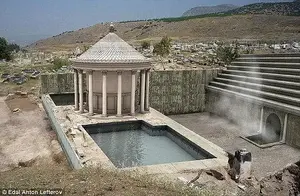
Roman priests who survived religious journeys through a deadly 'gate to hell' may have had a helping hand from their height, new research has found. This image shows a digital reconstruction of the site, which was discovered by a team of archaeologists from Italy in 2013
Researchers at the University of Duisburg-Essen in Germany measured carbon dioxide (CO2) concentrations in the arena of the ancient city of Hierapolis.
The city is in a particularly active region in terms of geology, with thermal springs and rifts deep under the city causing mists to pour out of the ground.
The 'gate to hell' from which these mists issued forth was built directly into the walls of the arena.
Experts found that levels of the potentially deadly gas contained in these vapours were lower during the day, when the sun's rays would cause them to dissipate.
Throughout the night, these clouds form into a lake of CO2 at the base of the enclosed arena.
Levels were particularly high at dawn, when concentrations 15 inches (40 cm) above the arena floor reach 35 per cent.
This would be more than enough to cause animals and people to choke to death but humans, by virtue of their height can hold their heads above the lethal levels of the gas.
Volcano biologist Hardy Pfanz, who led the research, said: 'They knew that the deadly breath of [the mythical hellhound] Kerberos only reached a certain maximum height.'
The ancient city of Hierapolis was founded around 190BC by the Greek King of Pergamum, Eumenes II, and was taken over by the Romans in 133BC.
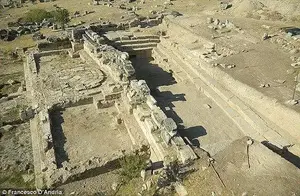
Researchers at the University of Duisburg-Essen in Germany measured carbon dioxide (CO2) concentrations in the arena of the ancient city of Hierapolis. This image shows the site as it appears today

Experts found that levels of the potentially deadly gas contained in these vapours were lower during the day, when the sun's rays would cause them to dissipate. This 3D reconstruction of the Plutonium at Hierapolis shows the The Gate to Hell in the rear wall, below the stone seating

Levels were particularly high at dawn, when concentrations 15 inches (40 cm) above the arena floor reach 35 per cent. This image shows steps next to the temple from where people were believed to watch the sacred rites
HOW WAS THE ROMAN 'GATE TO HELL' DISCOVERED?
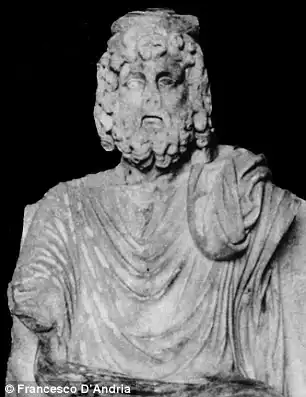

Archaeologists believe that a large statue found at the site, previously believed to depict Apollo, is actually of Hades, Greek god of the underworld
Archaeologists reported in 2013 that they had discovered the 'Gates of Hell', a mythical portal to the underworld in Greek and Roman legend.
The site, in the ancient Phrygian city of Hierapolis, now Pamukkale in southwestern Turkey, closely matched historical descriptions of what was known as Ploutonion in Greek and Plutonium in Latin
In its heyday, a small temple with traditional Greco-Roman pillars was stated to have stood next to wall with steps leading down to a cave doorway filled with foul and noxious gasses.
Describing the site, the Greek geographer Strabo, who lived from around 63 BC to 24 AD, said: 'This space is full of a vapour so misty and dense that one can scarcely see the ground.
'Any animal that passes inside meets instant death. I threw in sparrows and they immediately breathed their last and fell.'
A team led by Italian Archaeologist Francesco D'Andria, professor of classic archaeology at the University of Salento, discovered what they believe to be the ruins of the site.
Mr D'Andria stated he and his team managed to pinpoint the location by reconstructing the route of a thermal spring.
Among the ruins the archaeologists found a cave with Ionic semi columns upon which were inscriptions with dedications to the gods of the underworld, including Pluto, also known as Hades.
Researchers saw several birds die as they tried to get close to the warm opening, instantly killed by carbon dioxide fumes.
Under Roman rule the city flourished. There were temples, a theatre and people flocked to bathe in the hot springs which were believed to have healing properties.
The site remained fully functional until the 4th century AD and became an important pilgrimage destination for the last pagan intellectuals.
Historians believe the site was sacked by Christians in the 6th century AD, with several earthquakes adding to the damage.
Today Pamukkale is well known for the stunning white travertine terraces which are the result of the hot springs.
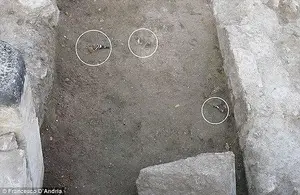
This would be more than enough to cause animals and people to choke to death, but humans can raise their heads above the level oft the gases. A previous study found that birds which flew too close to the opening were killed by the carbon dioxide fumes (circled)
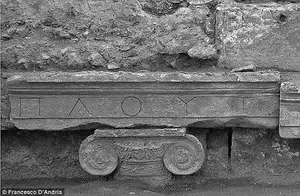
Among the ruins archaeologists who discovered the site found a cave with Ionic semi columns upon which were inscriptions with dedications to the gods of the underworld, including Pluto, also known as Hades

Today Pamukkale is well known for the stunning white travertine terraces which are the result of the hot springs (pictured)
The ancient Greek historian Strabo visited the Plutonium, named for Pluto, god of the underworld, at Hierapolis around 2,000 years ago.
He noted that the priests were able to place their heads into the gate to hell without suffering any ill effects.
Strabo believed their status as eunuchs caused this immunity
The full findings of their research were published in the journal Archaeological and Anthropological Sciences.

The site, in the ancient Phrygian city of Hierapolis, now Pamukkale in southwestern Turkey, is stated to closely match historical descriptions of the Roman gate to hell